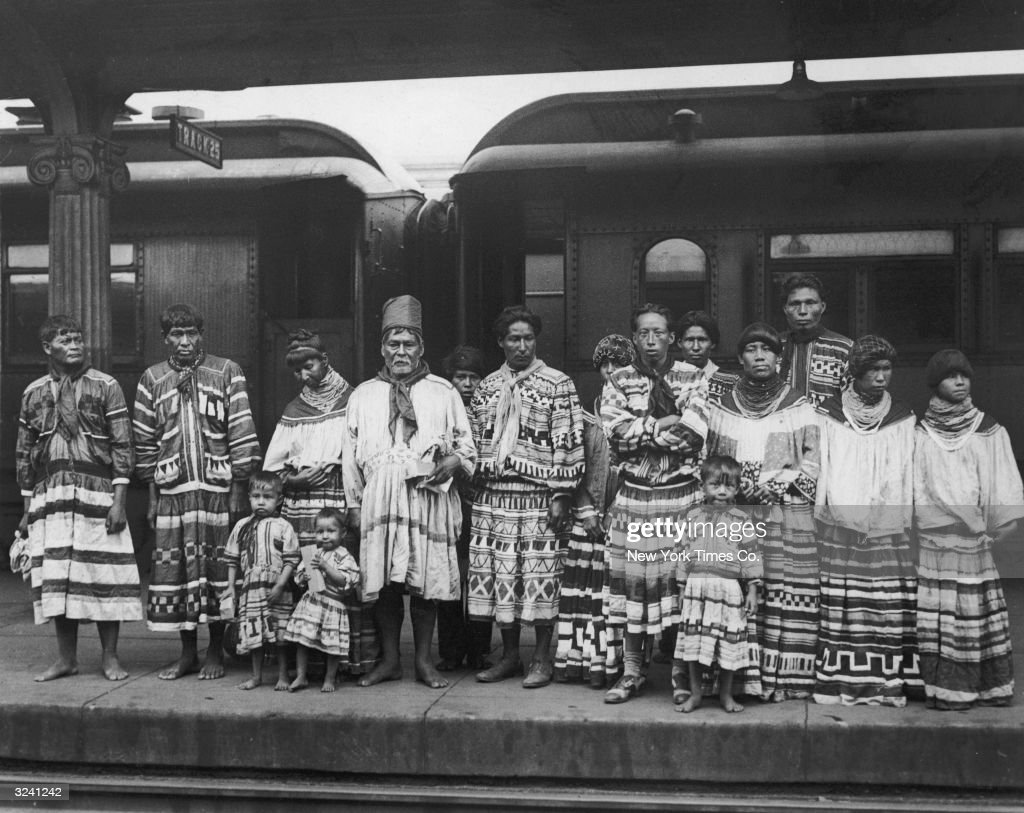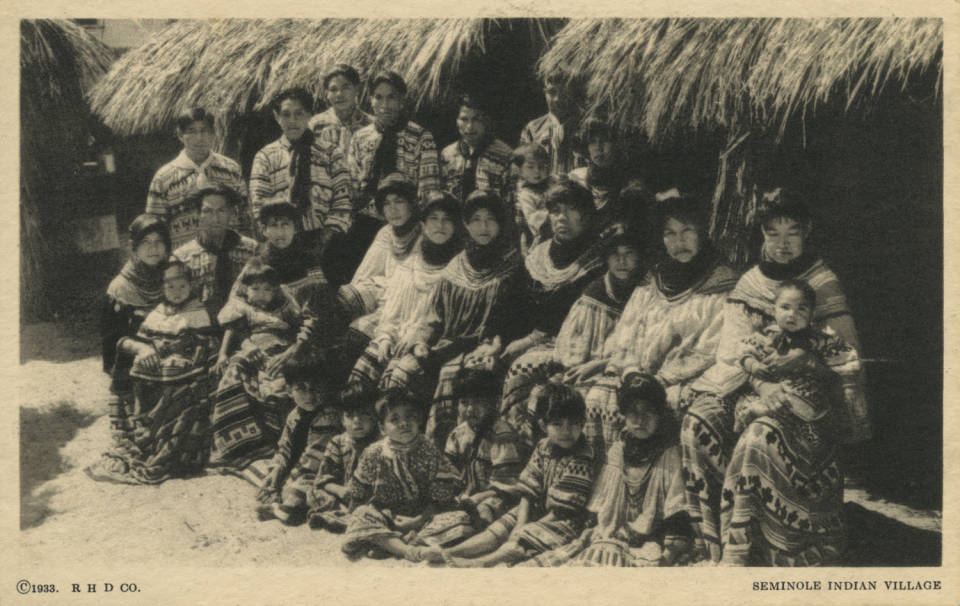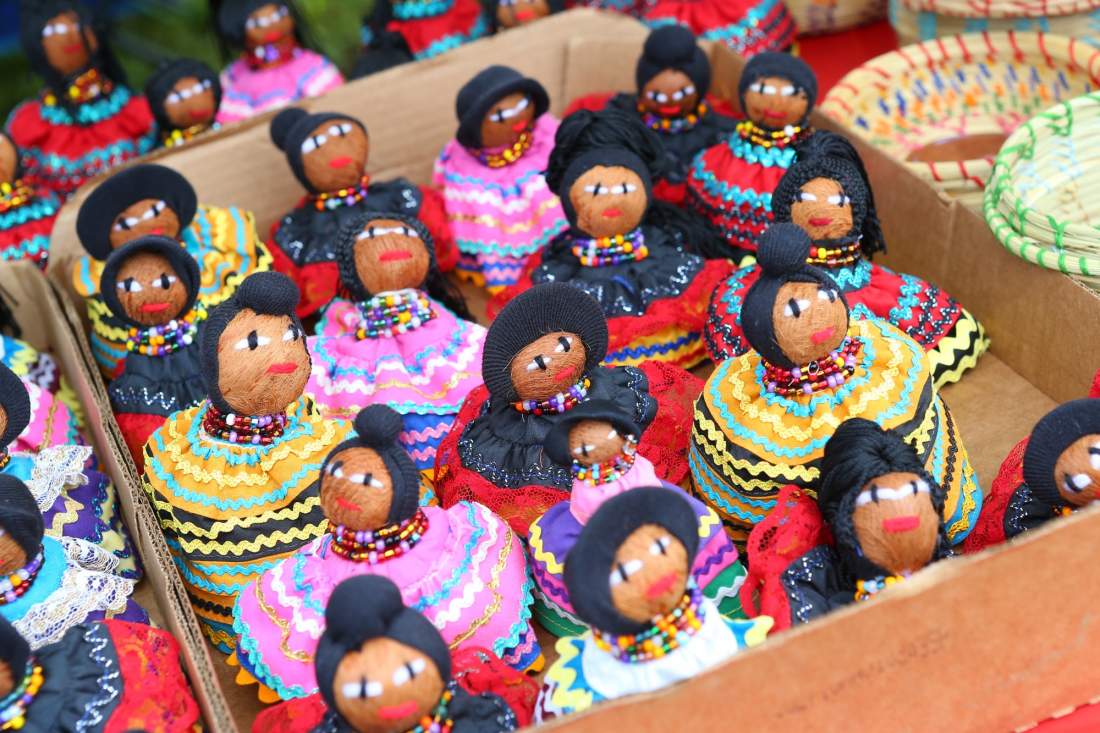
The 1930s, Age of Exhibition Shows
Welcome back to our Decades of Seminole Tourism series! This week, join us as we look back to the 1930s. Marked by the Great Depression, the 1930s saw big changes for Florida tourism that would have long-lasting impacts. Florida began to change its image to one of a tourist destination for all. This would eventually lead to the Florida we know today–fueled by the tourism economy. While permanent attractions like Musa Isle were still popular, some Seminole people also began to travel to the exhibition shows. This week, learn all about the complicated history of Seminole exhibition shows and fairs, as well as their long-lasting impacts on Florida tourism.
In the featured image, we can see a row of thatched chickee roofs at Musa Isle in the 1930s. To learn more about Musa Isle and other permanent Florida attractions of the time, visit a previous blog post on the 1920s!
Florida Tourism in Trouble
Florida tourism was struggling going in to the 1930s. In the 1920s, Florida experienced an unprecedented real estate land boom. Development projects and the draining of the Everglades opened more land. Henry Plant and Henry Flagler built lavish resorts along their popular rail lines, enticing rich vacationers. Those same rail lines, along with steamboats and new roadways, allowed easier movement throughout the state. As a result, there was a massive influx of people and newly available land. In the official 1925 state census, the population of Florida was 1,263,549 people. In only five years since the 1920 census, Florida added almost 300,000 residents. As a result, the early 1920s were marked by speculative real estate investments, rising housing and food prices, and vigorous expansion.
Soon, the real estate bubble would burst. A series of events, including the 1926 Miami Hurricane and the 1928 Okeechobee Hurricane, would spell the end of Florida’s first land boom. Subsequently, many came out of the bust financially bankrupt. Coupled with the pressures of the Great Depression, enticing visitors to Florida was no longer an easy task. People were hesitant to settle in Florida, as well, and financial pressures discouraged vacationers.
Around the same time, certain people within Florida’s state government were becoming aware of the potential possibilities surrounding Florida tourism. To maximize that potential, there was renewed interest in featuring Florida prominently in advertisements locally and across the country. The natural result was increased involvement in exhibition shows and fairs, particularly the three discussed below. Without a doubt, this involvement would change the face of Florida tourism. Seminoles were a vital part of the success of these shows, although many were hesitant to attend.
Exhibition Shows: A Mixed Bag
Concerned about being sent to Oklahoma or left behind, Seminoles were often difficult to persuade to participate in exhibition shows. Additionally, the trips were “demanding, up to seven months in length. Cold climates, absence from kinsmen who provided structure for the culture, and missing important socioreligious events…were further drawbacks (West 154).” For safety, “significant northern exhibitions featuring large Seminole village attractions were arranged and managed by Miami attraction personnel, whom the…participants knew well (West 154).” But, they were still significant time investments, and difficult to handle. The first major non-Florida exhibition show with Seminoles present was Toronto’s Canadian Exhibition in 1931. Traveling to shows and fairs within the state of Florida had been a long-time activity since the 1910s. But, traveling out of state (or country) for long-term exhibitions did not happen consistently until then. As a result, the 1930s represent the peak of Seminole involvement in exhibition shows.
In looking at Seminole involvement in exhibition shows, it is important to note the ethically murky image it presents. Historically, exhibition shows featuring indigenous groups like this don’t paint a great picture in 2022. It is a complicated historic moment, and honestly one that provided both positives and negatives for those involved. For Seminoles, “the exhibition tours to northern cities appear to have been looked on as little more than just another job (West 149).” These jobs, like others at permanent attractions like Musa Isle and Coppinger’s, helped shape who the Seminole Tribe of Florida is today. Therefore, they are important moments in Seminole history to look at critically and thoughtfully. For the sake of this blog post, we are endeavoring to present Seminole history in its most accurate and honest light.

1931: A group of Seminole Indians from Dale County, Florida waiting to change trains in Washington, DC while en route to Toronto, Canada, where they participated in the Canadian National Exhibition. (Photo by New York Times Co./Getty Images) Photo credit incorrectly listed as “Dale” County; should say “Dade” County.
Toronto’s Canadian National Exhibition, 1931
In 1931, the Miami and Miami Beach Chambers of Commerce partnered to sponsor an exhibit at the Canadian National Exhibition in Toronto. As touched on above, the three shows discussed in this blog were all staffed and arranged by liaisons from Miami attractions. Henry Coppinger Jr. of Coppinger’s was tasked with arranging Seminole participation for this show. It was not an easy go. Rivalry “tempered by a genuine concern about the welfare of those who would make the journey” caused Musa Isle employees to try and sabotage the project (West 135). Eventually, Coppinger was able to get some people interested, and the journey was set. Despite some interference, about half of the expected participants ended up making the journey. These people included John and Ida Osceola with daughter Tihokee, Katie and Josie Jumper with children Moses and Laura Mae, Sam Huff, and Chestnut Billie.
Boxcars filled with 30,000 palmetto fans to thatch chickee roofs, entire coconut trees, and 500 alligators were included on the trip (West 137-8). Rented sewing machines, bolts of fabrics, and threads also made their way north. Each family received $35 a week compensation, plus food, for the duration of the exhibition. The exhibition was a great success, with some people like Katie and Josie Jumper returning in 1932. While this exhibition show was well funded, the reality is that some exhibition shows were risky, low-budget affairs. Seminole agent James L. Glenn condemned shoddy exhibition shows, saying “Some white men would get a group of Seminoles to go with him to exhibits and fairs throughout the nation. If he got enough money out of it, he would bring the Indians home. But if his business venture did not pay out, he would desert them (West 141).”
Chicago’s Century of Progress World’s Fair, 1933
With great success in Toronto, the 1933 Century of Progress World’s Fair in Chicago was probably the exhibition with the most long-term impacts for Florida tourism. Organized by the same group as the Canadian shows, it ran from May 27 through November 13, 1933. It was the longest exhibition thus far for Seminole participants. Participants included the Johnny Busters (and children Junior, Mary, and Sally Johns), Katie and Josie Jumper (and children Moses and Laura Mae), Josie Billie, George Osceola, and Chestnut Billie (West 145).
Much like the previous shows, coconut and banana trees were planted, chickees constructed, and alligators and sewing machines were included. But, despite each family receiving $50 a week, most felt this tour was much too long. In five and a half months, “conservative estimates indicate that 23 million people visited the fair during the summer, with 9 million of those touring the Florida exhibit (Nelson 452).”
The Florida exhibit at the Century of Progress World’s Fair represents a pivotal image change for the state. For the first time, Florida was leaning directly into tourism in a wholehearted way. Tourism was a burgeoning industry, one that Florida could dominate. One advertisement sought the support of rural Floridians, stating that “the tourist crop is worth six times that of the citrus crop (Nelson 447).” Florida’s image began to change to that of a tropical paradise for any vacationer. The success at the Century of Progress in 1933 spawned huge interest.
As a result, the “public embraced this new focus and fueled the tropical, exotic image of Florida. Alligators, hammocks, springs, citrus, Seminoles, and Spanish conquistadors moved from background decorations for ostentatious resorts and themed nightclubs to become the central attractions for the state (Nelson 452).” This image would drive Florida tourism higher than ever before and make it one of the biggest industries in the state.

1933. Fresno State Library. “Seminole Indian Village.” Chicago’s Century of Progress.
New York World’s Fair, 1939
The same group that put on the Canadian and Chicago shows organized the 1939 New York World’s Fair. It was the longest exhibition by far; a painful seven months. This exhibition show seems to have been the most difficult, not only for the length, but also the climate. New York was cold. Heaters were installed to battle the low temperatures (West 147). Coconut trees and crocodiles perished, although the alligators resiliently survived. Fifty Seminoles attended this long exhibition, which began on April 18, 1939. Like the previous shows, it included a full-scale Seminole Village, tropical plants and animals, sewing and cooking demonstrations, and alligator wrestling. The 1939 New York World’s Fair marks the end of the peak for Seminole people at exhibition shows, but not Seminole involvement in tourism.

1939. New York World’s Fair. Manuscripts and Archives Division, The New York Public Library. “Amusements – Villages – Seminole Village – Indians” The New York Public Library Digital Collections.
While the exhibition tours outlined above happened far north of Florida, Seminole life continued. Tourist camps and permanent attractions operated along Tamiami Trail and the rivers of Miami and Fort Lauderdale. In this period, Seminole arts and crafts became even more intricate and developed. In the 1930s, “Alice Marriott, a specialist with the Indian Arts and Crafts Board, aptly noted on a visit to the Seminoles, ‘Seminole arts and crafts are Seminole life (West 127).” All this development, from Seminole crafts to exhibition shows, can be seen in Seminole tourism today. As Florida and the Seminole people moved further into the 1940s, tourism became even more intimately tied with their success and survival.
Sources:
The author accessed these sources digitally. Page reference numbers may not align with paper and hardback copies.
Evans, Jon S. “Weathering the Storm: Florida Politics during the Administration of Spessard L. Holland in World War II.” Dissertation. 2011. Florida State University Libraries. https://diginole.lib.fsu.edu/islandora/object/fsu:253845/datastream/PDF/view
Nelson, David. “When Modern Tourism Was Born: Florida at the World Fairs and on the World Stage in the 1930s.” The Florida Historical Quarterly, vol. 88, no. 4, 2010, pp. 435–68. JSTOR, http://www.jstor.org/stable/29765121.
West, Patsy. The Enduring Seminoles: From Alligator Wresting To Casino Gaming, Revised and Expanded Edition. 2008. University Press of Florida. Digital.
Author Bio
Originally from Washington state, Deanna Butler received her BA in Archaeological Sciences from the University of Washington in 2014. Deanna moved to South Florida in 2016. Soon, she began working for the Seminole Tribe of Florida’s Tribal Historic Preservation Office. Deanna was the THPO’s Archaeological Collections Assistant from 2017-2021. While at the THPO, Deanna worked to preserve, support, and process the Tribe’s archaeological collection. She often wrote the popular Artifact of the Month series, and worked on many community and educational outreach programs. She lives in Fort Myers, FL with her husband, son, and dog.



